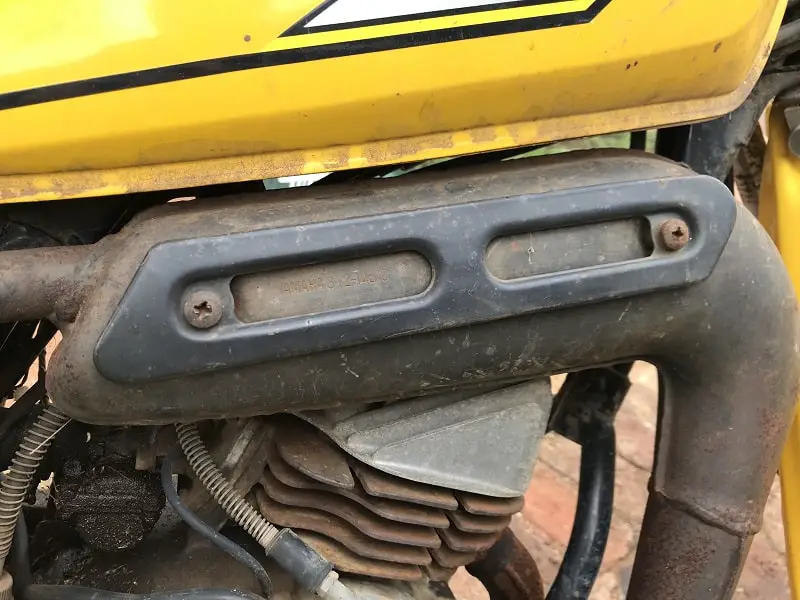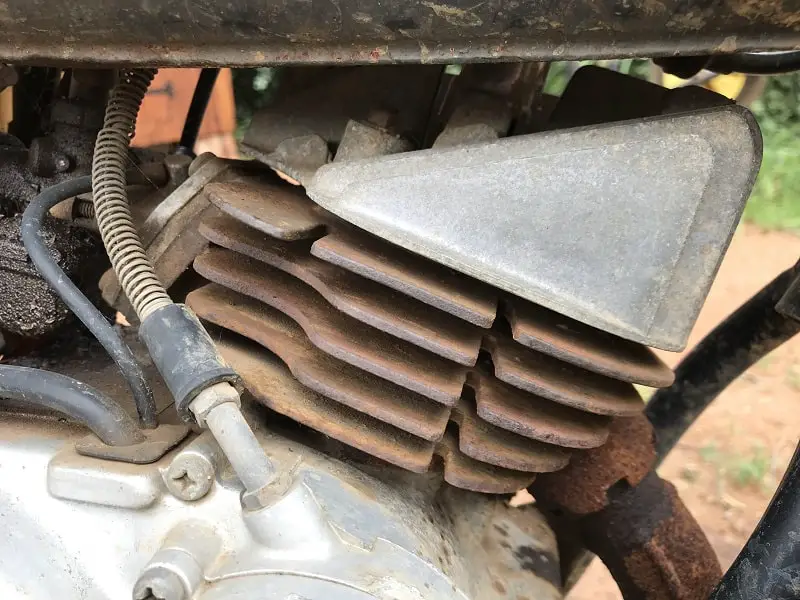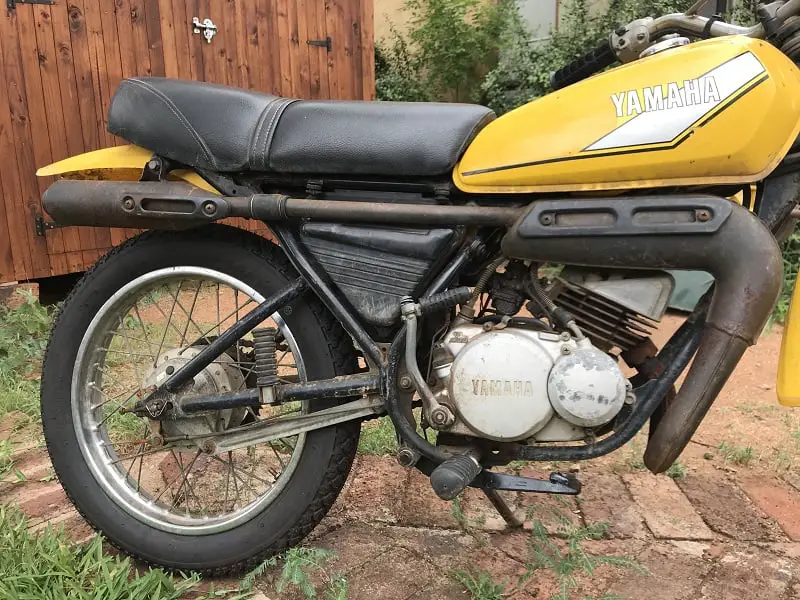Have you ever wondered why a 2-stroke motorcycle is louder than a 4-stroke? I can’t ride my 2-stroke in my yard, as the neighbors would certainly complain. Here are 7 reasons that contribute to making a 2-stroke motorcycle louder than a 4-stroke.
#1: Sonic Waves in the 2-Stroke Exhaust
Two-stroke engines do not have intake and exhaust valves to regulate the flow of fresh air into, and exhaust gas out of the combustion chamber. As the piston moves up and down in the cylinder, it exposes openings in the cylinder walls where air is drawn in or expelled.
In order to help contain fresh air on the compression stroke, sonic waves are reflected by the purposely tuned exhaust. As a result, there are two sound waves leaving the exhaust on every stroke (or combustion cycle) resulting in a higher frequency or pitch, and therefore louder noise. That’s also why 2-strokes have that familiar “hin-hin-hin-hin” sound.

In 4-stroke engines there is only one exhaust sound wave every other combustion cycle and therefore a lower frequency and quieter motor.
#2: Air-Cooled Motors are Louder
The majority of 2-stroke motorcycles are air-cooler instead of liquid-cooled. This means that the cylinder walls are thinner as there is no water jacket around the combustion chamber. On liquid-cooled four-strokes, the noise from the explosions in the engine has to pass through the thicker cylinder walls and water channels before it can bug your neighbors.

While you do get air-cooled four-strokes (like my Honda XR 650 L) and liquid-cooled two-strokes (like my Beta Rev3 trials bike), fours are generally liquid-cooled and 2-strokes, air-cooled.
#3: Free-Flowing 2-Stroke Exhaust
A two-stroke engine, by design, has no dedicated exhaust stroke as in four-stroke motors. Instead, the cylinder opens the exhaust port close to the end of the power stroke. In order to get rid of the burnt exhaust gas quickly, a 2-stroke motorcycle requires a free-flowing exhaust to clear the combustion chamber.

Another reason for free-flowing exhausts on 2-stroke motorcycles is to keep the weight down. Dirt-bikes often use two-stroke engines to ensure maximum power-to-weight ratios for racing and jumping.
A free-flowing exhaust is much louder than a restricted exhaust with a sound-deadening muffler. Almost all road-legal motorcycles these days are four-stroke because of this. Four-stroke engines can run properly with a restricted exhaust and therefor result in lower carbon-monoxide emissions. With more stringent emission regulations introduced every year, that’s why you don’t see street bikes with two-stroke engines anymore.
#4: 2-Strokes Do Not Have Valves
Two-stroke motorcycle engines do not have intake and exhaust valves like four-strokes. And since the exhaust power in the cylinder wall opens near the end of the power stroke, the outside world (and your ears) are exposed to the mini explosions in the combustion chamber.
In 4-stroke motors, the valves are completely closed during the full power stroke and only open once the piston starts its way up in the cylinder again. By the time the exhaust valves open, the explosion inside the engine is over and only exhaust gases come out the tail pipe.
#5: Twice the Explosions in a 2-Stroke
Due to the design of the 2-stroke engine, there is an explosion (or power stroke) during every single revolution of the engine. When the piston goes up, it draws in the vaporized air/fuel mixture and compresses it. At the top, it ignites, causing the piston to go down with force (the power stroke) and at the end it expels the exhaust gasses through the exposed exhaust port.
In a four-stroke motor, this violent (and noisy!) explosion only happens every other revolution of the engine. On the first down stroke the air/fuel mixture is drawn in through the inlet valves. As the piston goes back up it compresses the gas which is ignited at the top. It then races down (power stroke explosion) and push the burned gas out the opened exhaust valves as it goes back up again for the second time.
These differences mean that two-strokes make loud explosions twice as often as four-strokes for any given number of engine revolutions (rpm). More explosions mean more noise!
#6: Different Riding Style on a 2-Stroke Motorcycle
These days, the majority of two-stroke motorcycles are dirt bikes. Dirt bikes are mostly used for racing or recreational riding. These bikes are generally not street legal and therefore not used to commute or ride on public roads in a relaxed manner. Instead, dirt bikes are used to ride around motocross tracks or up and down dirt roads. Just listen to my Beta Rev3 trials bike in the video below:
Since dirt bikes are ridden for fun, they are constantly under hard acceleration. Dirt bike riders don’t putter along to get a thrill, they open the throttle hard and often. This means that the engine reaches high rpms often which results in lots of noise. Brrraaap!
#7: Two-Stroke Power Delivery
Two-stroke engines develop maximum torque at higher rpms than four-strokes. At lower rpms these bikes can feel a little slow, but when that torque curve (also known as the power band) hits, these bikes take off like rockets.
As a result of the power band only kicking in at higher rpms, two-stroke bikes are mostly ridden high up in the rev range, resulting in that distinctive two-stroke scream.
Conclusion
While four-stroke engines can make a lot of noise (think Harley rumbles and sports bikes racing down the street), two-stroke motorcycles generally make more noise than four-strokes. Since most two-stroke motorcycles are not plated and therefore do not have to adhere to the same stringent regulations as road-going bikes, they are allowed to be more noisy.
The above seven factors combined is what makes a 2-stroke louder than a 4-stroke.
Brrrraaaap!

